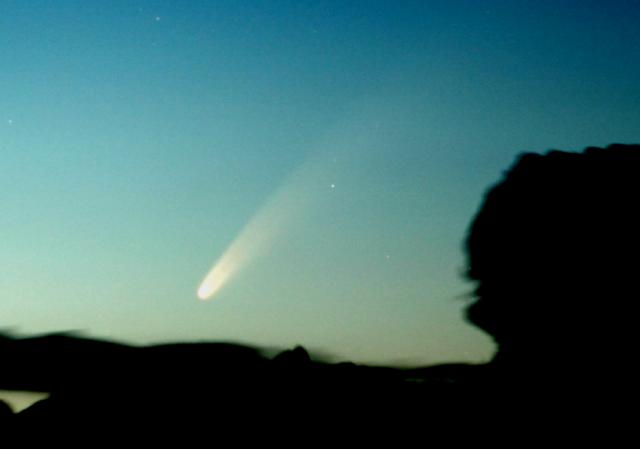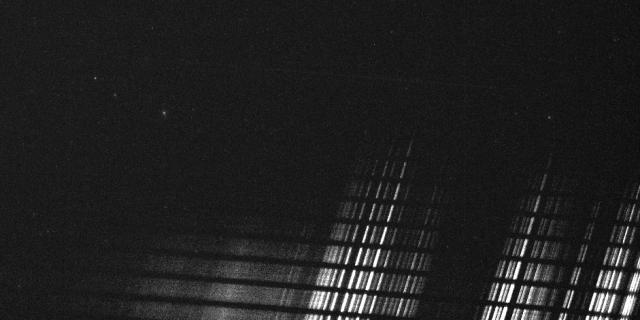Forum Replies Created
-
AuthorPosts
-
 Bill WardParticipant
Bill WardParticipantHi,
There have been a couple of pictures circulating on twitter apparently showing a yellowish ion trail. Seemed entirely possible to me, given the observations made on Hale-Bopp in 1997. I ventured that the colouration was probably real.
There’s an interesting subsection in the book Cometary Science by Crovisier and Encrenaz, CUP, 2000, pg 44 on the Hale-Bopp sodium tail, it has the phrase “the origin of cometary sodium is still a puzzle”. Seems still to be after 23 years!
I think it boils, literally and metaphorically!, down to the refractories in the nucleus, this may just be a quirk of the comets’ own formation. It’s there, so it must be in the minerals present.
In my spectroscopic meteor observations there are occasional meteors which exhibit very strong sodium emission also, I have often wondered if they somehow related to particular comets. The standard thinking seems to be that they are “fresh” meteoroids from which the sodium had still be be “boiled off”, so maybe yes, maybe no….
Do you have higher resolution spectra of the comet? I have seen nothing of the comet for a week and probably won’t for another week! The only thing I have for “stellar” spectroscopy now is a star analyser, I’ll give that a go if the opportunity presents itself.
Cheers,
Bill.
 Bill WardParticipant
Bill WardParticipantHi all,
I had my first decent evening for the month on 7/8 July 2020. 2020 F3 had just become circumpolar from my latitude but at 56N it is still very bright even at 00UT. Anyway, a cloud bank situated on the horizon seemed to have the remarkable property of being synchronised with the earths rotation and sat exactly over the comet for two hours before allowing me a brief observing slot!
As the cloud was dancing around I took a few shots through 300mm f4 and 400mm f4 lenses. Being very amateurish and rushed, I didn’t even note the time accurately, all I can say is that it was around 0010UT 8/7/20 very faint to naked eye. Image is a stack of 11 x 1 sec but background was just too bright to get the ion tail. Looked nice in 11×80 binoculars, tail maybe 1/2 to 3/4 degree long to me eyes.

Then the cloud covered it again and resumed its synchronised motion all the way to 03UT! grrrrr…
Sometimes it is really difficult not to take it personally…. ; – )
Might get to see it again next week….
However, as compensation, there were some remarkable NLC that night!
Cheers,
Bill.
 Bill WardParticipant
Bill WardParticipantHi,
Is it Ernie or Stan…? ; – )
Have you had a look at at he NEMETODE site? (http://www.nemetode.org/) I know that there are efforts to get all the various groups to report in a common format but knowing people, everybody will stick with what they’re comfortable with, I do, it’s only a hobby after all!
However, the NEMETODE guys have a ton of material and an excellent email group run by Alex. You might want to contact him and see if any of those guys caught it. You should be able to contact him through this site (if you haven’t already done so…!)
cheers,
Bill.
 Bill WardParticipant
Bill WardParticipantHi,
Thanks Jack.
When I get a bit of time I’m hoping to review all of this years captures to try and get some numbers on how many exhibit this type of behaviour. Maybe a summer time project when I switch my gear off for a clean up around the solstice.
Cheers,
Bill.
 Bill WardParticipant
Bill WardParticipantHi Dennis,
Me too! It is a right royal pain in the celestial bum for my HD meteor camera system!
Progress, they say….
Cheers,
Bill.
 Bill WardParticipant
Bill WardParticipantGreat catch,
It looks like a stony job with a very strong magnesium line and early start sodium. If you get an orbit, I’d bet on a low-ish Vg….
Cheers,
Bill.
 Bill WardParticipant
Bill WardParticipantHi,
Yep, looks like a pair of “biologics” to me…. viz birds!
Cheers,
Bill.
 Bill WardParticipant
Bill WardParticipantHi,
I captured another remarkable “melting” meteor last night. Meteor seems to fragment into a “cloud” of material then trail behind the faster moving meteor head.
Cheers,
Bill.
 Bill WardParticipant
Bill WardParticipantHi,
Being away from home over the new year I was unable to do any spectroscopy. Given the weather I don’t think that would have been very successful anyway… ; – )
I did, however, attempt some visual observing from where I was, just outside Dundee, and for a brief spell I thought is was going to hold. Alas, no but I did see 2 Qua’s and 1 Spo in just under an hour. Nice to see the real thing from time to time…
My radio system kept vigil on my behalf and I was surprised to see that in terms of the maximum meteor count this years QUA’s pipped the 2019 GEM’s for the highest rate. 156 QUA’s 04-05UT verse’s 143 GEM’s also 04-05UT. Of course the GEM rate is pretty high over a much longer period…
I’ll put together some graphs at some point but it looks like it would have been a nice show given some clear skies.
cheers,
Bill.
 Bill WardParticipant
Bill WardParticipantHi,
I’m not sure what happened to the original picture so here’s another version in case anyone wants a look…
This is the original orientation and full size from HD frame. It also has been contrast stretched to show the faint lines.

Even though it looks like I only got the start of the meteor, it’s just brilliant!
Cheers,
Bill.
 Bill WardParticipant
Bill WardParticipantHi,
Thanks and thanks for the kind offer Jack. I’ve got a pdf copy (from the NIST site) of the Multiplet Tables. These “old” works are invaluable even today!
I generally use a selection from the NIST persistent lines catalogue. This has proved an excellent source of data for meteor stuff. Although I don’t think I’ll ever get to needing 0.0001A resolution on my spectra, but you never know LOL! : – )))
cheers,
Bill.
PS. Given I’ve found some other metals I suppose I should change the topic title to “Mostly” iron meteor spectrum… ; – )
 Bill WardParticipant
Bill WardParticipantHi All,
After tweeting a re-worked spectrum it seems the meteor was captured on an all sky system (Jamie in Lochearnhead). He estimates it was -3.
I decided to re-work the spectrum as I hadn’t really paid much attention to the “thermal tail” between 550nm and 650nm. With the increased resolution I now have I’m more confident about identifying more exotic lines.
It looks like there are some weak lines from Tungsten, Vanadium and Manganese in the mix! I’m pretty sure there’ll be Nickel in the meteoroid but these tend to have their strongest emission in the deeper UV, just beyond my detection limit.
This one really was a cracker and a step forward in observation capability. There are some older observations claiming up to 70 lines in a spectrum but that was based on a spectrum that actually had 27 native lines in the image. The assumption was that the other lines were there because they had emissions at particular wavelengths and were blended together. Using that method and modern data I could claim well over 100 lines here, but I’m not sure if that is really honest science. Anyway, from my element list I count 60 native lines in this spectrum without any assumptions of blending.
cheers,
Bill.
 Bill WardParticipant
Bill WardParticipantAn awful lot of variables so strictly “order of magnitude” (the physicists get out of jail free card!) number…
The column diameter of the train is ~ 30 to 50m. Remarkable to consider that the meteoroid itself might only have been a couple of mm in diameter. The atoms evaporate off at a few km/sec but bump into the atmospheric atoms after a few free path lengths, a few metres then diffuse into the atmosphere over however long depending on size, mass, density, composition, velocity etc etc.
Most of those we have little or no idea about…!
Cheers,
Bill.
 Bill WardParticipant
Bill WardParticipantThanks!
Bill.
 Bill WardParticipant
Bill WardParticipantWhat was the scope/camera (pixels and pix size)/exposure you used? Could you send me the raw frame of the second shot?
Just curious to see if I can make some measurements….
cheers,
Bill
 Bill WardParticipant
Bill WardParticipantLucky catch!, Certainly does look like a faint wind distorted train in the second field.
So I’m going to say, probably… ; – )
 Bill WardParticipant
Bill WardParticipantAhhhh the road to hell is paved with good intentions….
Well almost, must be 12 years ago I had the balloon, the helium and the instrument…
I must confess not for meteors though, part of a student project that both literally and metaphorically never got off the ground! Could never get the remote control and radio data link to work properly. It was going to be looking at cosmic rays but I thought it would be a great idea to fly it at night with a camera just out of curiosity. Bounced due to health and safety concerns… ; – (
…and the nice big meteorological balloon perished without ever being inflated…
Somebody will do it with a Pi and an IMX camera!
22 November 2019 at 10:33 am in reply to: Prediction of high activity of alpha Monocerotid shower #581634 Bill WardParticipant
Bill WardParticipant… and looking at the RMOB site it looks like my radio system hung yesterday!
also bl**dy typical! ; – ((
22 November 2019 at 8:49 am in reply to: Prediction of high activity of alpha Monocerotid shower #581630 Bill WardParticipant
Bill WardParticipantAbsolutely nothing here although it did clear just prior to dawn… typical!
21 November 2019 at 2:23 pm in reply to: Prediction of high activity of alpha Monocerotid shower #581626 Bill WardParticipant
Bill WardParticipantHi,
The weather’s not looking so good here either but I may put out a couple of spectro-camera’s just in case.
That would be an interesting catch…
Cheers,
Bill.
-
AuthorPosts
